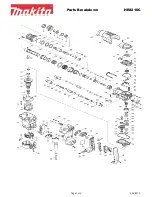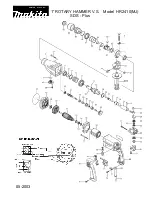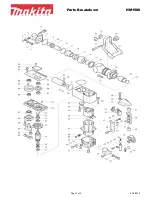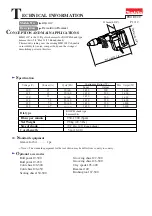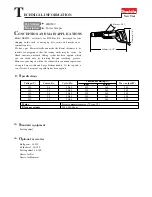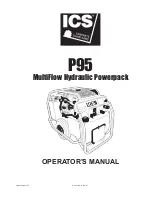
EN
EN-4
51955631_ed5
DANGER
The operator will be seriously injured if the tool breaks while he is riding the paving breaker with one leg over the Handle.
CAUTION
Riding the paving breaker handle creates excessive pressure on one side of the paving breaker, throwing it out of Alignment and
causing unnecessary wear on internal parts.
2. Immediately after starting the paving breaker, check for the presence of oil mist at the exhaust port and on the paving breaker tool. This is
the only assurance that oil is traveling all the way through the breaker. When checking the paving breaker for proper lubrication, always put
the tool against the work.
3. Release the throttle lever to shut the paving breaker off.
4. If exhaust freeze-up occurs, add anti freeze lubricant directly through the air inlet connection. Use an anti freeze lubricant recommended
for air tools.
Operational Tips
For maximum operating efficiency, observe the following suggestions:
a. Never strike the paving breaker with a blunt object; the housing may be broken or damaged.
b. Never attempt major maintenance of the paving breaker on the job; take it to a repair shop.
c. Never drag the paving breaker along the ground; the air ports in the exhaust may fill with dirt.
d. Always blow out the air supply hose before connecting it to the paving breaker to remove any dirt inside the hose.
e. Always be sure the paving breaker is well lubricated. Adjust the air line lubricator so that the paving breaker tool always shows an oil film.
There should be a fine mist of oil coming out of the exhaust port during operation.
f. Always keep rock drill oil in a sealed container so it doesn’t get contaminated with dust or dirt.
g. Do not operate the paving breaker when the tool is not against the work.
h. In extremely cold weather, keep paving breaker tools wrapped in burlap or cloth until just before you use them. At 0 ° F (-17.8° C) a
hardened steel tool loses about 80% of its normal shock resistance.
i. Always keep plastic caps or plugs in all ports when the paving breaker is not in service.
j. Work to the predetermined line (boundary) and grade (depth). Cut straight and cut neatly. To get the exact grade, use a tape measure or
ruler.
k. In certain applications, such as a pipe job where the grade is critical, it pays to over-excavate. If you try to excavate exactly to grade, even a
small piece of rock sticking up will throw the pipe off grade. To avoid this problem, excavate a little deeper than grade, then fill and compact
to the correct grade. This is easier than having to come back and break out more rock.
l. Always make a slight cut in a sidewalk or portion of a slab before breaking it. This is usually done with a masonry saw, but if it has not been,
use the paving breaker to cut along the designated line to ensure a clean break. When cutting asphalt, cut all the way through the asphalt
with each cut, as well as all the way around the perimeter of the area, before you break the asphalt out.
m. When excavating to a critical line for installation of a service, square the sides o the excavation as you work down. Other-wise, you’ll either
under-cut or over-cut.
n. When making an excavation to work in, it’s better to make a larger opening than required to provide ample working room. Observe all
safety precautions, procedures and regulations.
o. Always break any material to the point of “give”. This is accomplished by making sure you’re breaking the concrete or rock, not just cracking
it; otherwise, you’re not working to the point of give. Always clear away the rubble as you’re breaking the concrete, rock, or asphalt.
Uncleared rubble blocks your point of give.
p. Always take the right sized “bite” with the paving breaker.When starting to work the paving breaker in a material, experiment to find the
right sized bite for breaking that material efficiently.
If you take bites that are too big, it will be necessary to pry with the paving breaker tool. This could break the tool or damage the paving
breaker. The paving breaker is not designed for prying; it’s designed for breaking. Always use a pick to pry material free.
If you take bites that are too small, you’ll be working too slowly, and you’ll have to pick up and move the paving breaker more than
necessary.
q. Do not lift or transport the breaker by the throttle lever. Damage can occur to the breaker.
Parts and Maintenance
When the life of the tool has expired, it is recommended that the tool be disassembled, degreased and parts be separated by material so that
they can be recycled.
Original instructions are in English. Other languages are a translation of the original instructions.
Tool repair and maintenance should only be carried out by an authorized Service Center.
Refer all communications to the nearest Ingersoll Rand Office or Distributor.
Содержание MX60
Страница 23: ...Notes ...
Страница 24: ...ingersollrandproducts com 2014 Ingersoll Rand ...
























